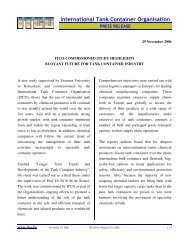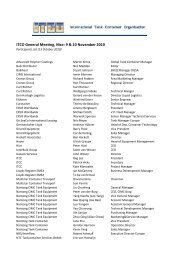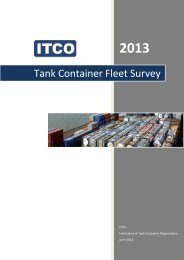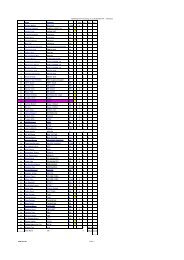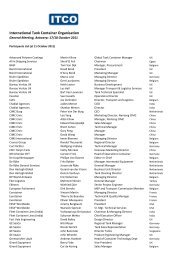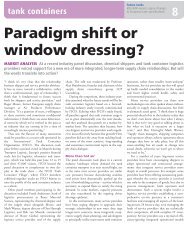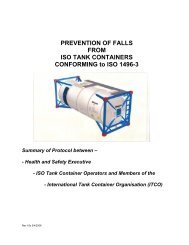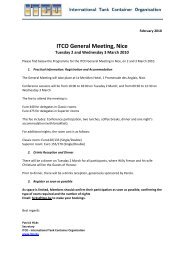You also want an ePaper? Increase the reach of your titles
YUMPU automatically turns print PDFs into web optimized ePapers that Google loves.
ICHCA International <strong>Safe</strong>ty Panel Briefing Pamphlet No 30<br />
SAFE HANDLING OF TANK CONTAINERS<br />
1 Introduction<br />
1.1 This document is one <strong>of</strong> a number <strong>of</strong> Briefing Pamphlets published by ICHCA<br />
International and forms one <strong>of</strong> a series on the safe handling <strong>of</strong> containers and<br />
container related equipment.<br />
1.2 In the freight container industry, the term “tank” usually refers to a 20 ft tank<br />
container consisting <strong>of</strong> a stainless steel pressure vessel supported and<br />
protected within a steel frame. <strong>Tank</strong>s are <strong>of</strong>ten thought to just carry dangerous<br />
goods.<br />
1.3 However this perception is far from the whole truth, as the term “tank” can<br />
cover a number <strong>of</strong> containment designs that carry all sorts <strong>of</strong> bulk liquids,<br />
powders, granules and liquefied gases; tank containers are a type <strong>of</strong> tank.<br />
<strong>Tank</strong>s come in various sizes, can be pressurised or non-pressurised and can<br />
be carried as a discrete cargo transport (or loading) units (CTU) or carried<br />
within another container.<br />
1.4 For the purposes <strong>of</strong> this pamphlet, the term tank container will be used to<br />
describe all tank designs covered within section 2. Where a specific type or<br />
design is being referred to directly it will be called by its type or design name to<br />
differentiate it from the generic tank container.<br />
1.5 This pamphlet will concentrate on the most significant designs which are<br />
generally 20 ft intermodal loading units designed to carry pressurised liquids or<br />
liquefied gases. However the text will include some information and details<br />
about as many <strong>of</strong> the various designs as is possible.<br />
1.6 <strong>Tank</strong> containers are built to the same exacting standards as other series 1 ISO<br />
freight containers and with a few exceptions can be handled in exactly the<br />
same way as all intermodal freight containers.<br />
2 Types <strong>of</strong> <strong>Tank</strong> <strong>Containers</strong><br />
2.1 ISO <strong>Tank</strong> <strong>Containers</strong><br />
2.1.1 Length 10ft (2.991m), 20ft (6.058m), 30ft (9.125m) and 40ft (12.192m).<br />
Under ISO 668 it would be possible to include a 45ft (17.192m)<br />
long unit to the list. However in the international tank industry<br />
approximately 95 % <strong>of</strong> all tanks built are 20ft long.<br />
2.1.2 Width 8ft (2.438m) wide<br />
2.1.3 Height Generally 8ft (2.438m) and 8ft 6in (2.591m). There are also “half<br />
high” tanks that are typically 4ft (1.219m) and 4ft 3in (1.296m)<br />
tall<br />
2.1.4 Volume 9,000 to 27,000 litres.<br />
2.1.5 Stacking The combined mass <strong>of</strong> the superimposed load shall not exceed<br />
the allowable stack weight shown on the <strong>Safe</strong>ty Approval Plate,<br />
generally 192,000 kg. Note: see section 12.2 for more<br />
information about stacking <strong>of</strong> loaded containers.<br />
2.1.6 Transport Can be carried on all modes <strong>of</strong> transport and deep and short sea<br />
routes within cells or on deck<br />
Page 1 ©ICHCA International Limited



